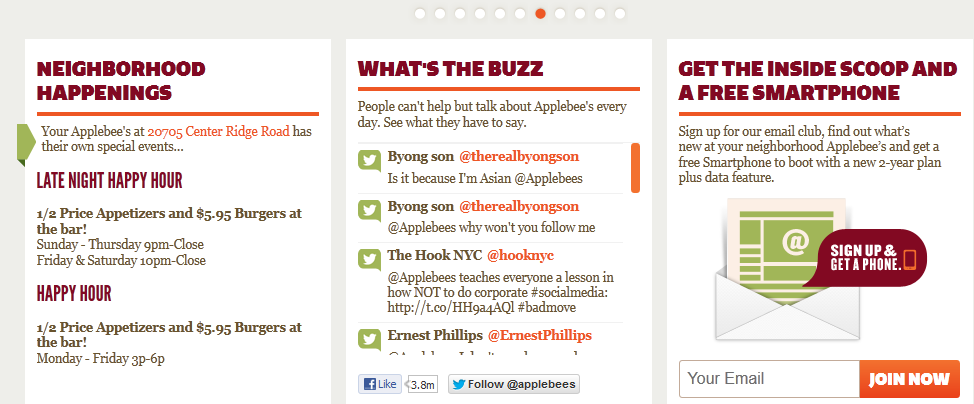Once something is posted on the internet, it can never really be erased.
It’s a truth that frequently manifests itself through social media. This permanence can snowball when combined with the other perpetual truth about the internet: everything has, at all times, the potential to move really, really fast.
On January 25, a pastor by the name of Alois Bell brought a church group with her to an Applebee’s in the St. Louis area. Upon finishing their meal, Bell did not pay the 18% mandatory gratuity that Applebee’s automatically adds to parties of eight or more, and added a note that read "I give God 10% why do you get 18?"
A fellow server took a photo of the check and posted it on Reddit – and promptly lost her job. By posting the check, server Chelsea Welch had violated employee guidelines on the topic of 'respecting and protecting the privacy of every guest.' Firing Welch proved to be an unpopular decision, and Applebee’s social media outlets were swarmed with negative attention about how they had handled the situation. Many people sympathized with Welch and wanted her reinstated, and some even offered to start an unemployment fund for her.
A Facebook user was browsing Applebee’s photos during this time and pointed out that Applebee’s had posted a photo of a receipt with a customer’s name plainly visible on their Facebook page just two weeks earlier. Once this was pointed out, Facebook users grew significantly angrier, and by 2 a.m. the next day there were around 11,000 comments on the original status.
Applebee’s social media team finally went on the defensive (strike one) at 2:53am (strike two), and began by posting a lengthy, seemingly insincere response to the backlash as a comment on their own status, where it was quickly buried by the flow of comments. Strike three!
Next they deleted the photo they posted two weeks earlier with the name of a customer in plain sight. They started deleting comments as well as tagging certain users and copy/pasting a generic response to their complaints. This went on well into the following morning, and even spilled over into Twitter.
The next morning, the status from 2:53am had been hidden, and many thought it had been deleted – leading to even more negative comments. Naturally, Applebee’s denies hiding or deleting any comments.
Applebee’s failed in almost every imaginable way in addressing this social media disaster.
Lessons we can learn from Applebee’s failure.
-
Don’t underestimate the power of responding to customers, especially dissatisfied ones, on social media. If your brand is on social media, you have an obligation to be, well, social. Responding to (even liking!) posts on social media sites feels personal to most users, and is a great way to display that your brand has an interactive, personal side to it.
-
Have a plan in place to respond to negative social media attention. Begin by assuming that maintaining a social media page exposes your brand to negative, irrelevant, or otherwise unwanted attention and that you will have to deal with it eventually. Plan for how you’ll react to various kinds of negative attention, even drafting anticipatory responses if necessary, since 3:00 a.m. heat-of-the-moment defensive responses will not come across in a positive or likeable way. Copying and pasting responses more than once on a status (even, really, on the same page) is quickly noticed and will relegate your page to the "insincere/this page doesn’t care" section.
-
Never delete negative posts or content, particularly as soon as they appear. This is seen as deceptive and a cowardly case of censorship. Deleting racist, offensive, or other NSFW posts is fine, but besides these cases, be light with the delete button. Applebee’s only made their situation worse by deleting the contradictory photo and the negative comments. Not only could they not keep up with the flood of posts, but they angered and extended the stay of posters who otherwise would have probably written their comment and left.
-
Don’t misrepresent or contradict yourself to your users, especially if they can quickly and easily call you on it. Applebee’s responded to angry Facebook users in the middle of the crisis who had their posts erased by strategically stating that no one deleted posts. This only further aggravated users. The discovery that Applebee’s social media team had broken the very same rule they cited when firing Chelsea Welch was the spark for this fire. If you hire a social media team, ensure that they are writing relevant content, engaging with people in a meaningful way, and, most importantly, following company rules.
-
Be careful when placing social media widgets on websites. Applebee’s has a live twitter widget on their home page that shows tweets @applebees as they occur. From what I can tell, these are not monitored – so any tweet, nasty or nice, appears on the front page. This is not smart. Not only has it probably been an especially painful read in recent days, Applebee’s exposes themselves to an endless variety of nonsense by not filtering their feed. Case in point:

If you want to promote your brand on social media (which you should!), be cautious. Be accountable and straightforward. Talk to people in meaningful ways, have some fun, and give people a reason to come back to your page over and over. The end result is a better brand presence, a great way to genuinely reach consumer segments, and, most importantly, happier customers.
***
How do you think Applebee’s could have handled this situation better? What would you have done if it were you?
